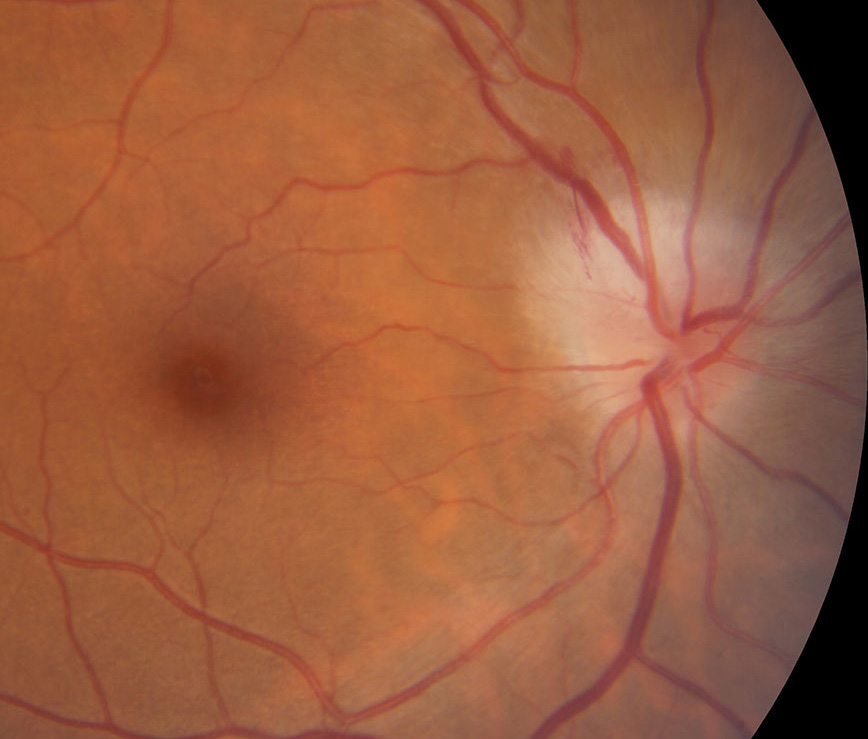 |
|
A recent South Korean population-based study, published in Ophthalmology, found that optic neuritis cases significantly decreased in the years following the COVID-19 pandemic. However, the research revealed a notable rise in ON cases associated with autoimmune diseases, such as multiple sclerosis, neuromyelitis optica and acute disseminated encephalomyelitis, suggesting a complex relationship between vaccines and neuro-ophthalmic conditions. Photo: Nate Lighthizer, OD. Click image to enlarge. |
When the COVID-19 pandemic broke out across the world, many wondered what impact the virus and the subsequent vaccine would have on other medical conditions: Would incidence rates rise or fall? Neuro-ophthalmic complications related to COVID-19 have been described, including optic neuritis, which involves damage and demyelination of the optic nerve, often resulting in permanent decreased visions. In order to assess if the incidence of optic neuritis (ON) was indeed higher following the COVID-19 pandemic, researchers in South Korea conducted a population study and discovered annual ON incidence significantly decreased compared to pre-COVID-19 levels. However, their findings uncovered a significant increase in ON patients who also received a diagnosis of multiple sclerosis, neuromyelitis optica or acute disseminated encephalomyelitis.
Published in Ophthalmology, this new study included 7,216 patients (52.7% female) diagnosed with ON between January 2017 and December 2022. Diagnoses were divided into four time periods: pre-COVID-19 (2017-2019), non-pharmaceutical intervention (NPI) period (2020), nationwide vaccination (2021) and nationwide infection (2022). There were a total of 3,770 South Korean patients diagnosed with optic neuritis pre-COVID; 1,193 diagnosed during the NPI phase; 1,135 during the vaccination period; and 1,118 during the infection phase. The annual incidence of optic neuritis during the three phases following pre-COVID significantly decreased when adjusted for age and sex. Researchers concluded that the NPI, vaccination or the infection itself did not appear to increase the risk of ON.
These findings refute initial case reports that loosely associated reports of ON developing in patients within 30 days of a confirmed COVID-19 infection, the researchers noted. “To our surprise, the results of our analysis implied that the risk of ON not only remained comparable but further decreased during the COVID-19 outbreak,” the authors wrote in the paper. They cite several possible reasons for this. First, strict public hygiene that led to a secondary decrease in other communicable infectious diseases; second, COVID-19 vaccination itself may have prevented demyelination by the virus or reduced the severity of the illness; and third, patients may have declined or deferred medical treatment for ocular conditions due to fears of contracting COVID-19.
“We believe that it is important to consider whether rare conditions like ON were falsely attributed to common factors such as COVID-19 infection or vaccination in prior studies,” they wrote. “Also, these findings support the public health benefit of vaccination and implementation of NPI such as social distancing as they have far outweighed the potential for rare neuro-ophthalmic complications.”
Even though vaccination didn’t increase the risks for optic neuritis overall, what did increase was the proportion of ON also containing diagnostic codes for multiple sclerosis (MS), neuromyelitis optica (NMO) and acute disseminated encephalomyelitis (ADEM). “In particular, the differences in the proportions of ON accompanied by diagnostic code for NMO within 60 days of ON diagnosis between 2019 and 2021 reached borderline statistical significance,” wrote the authors. “In this population-based study, we report increased proportions of ON associated with ADEM, MS and NMO during COVID-19 vaccination, and suggest that many ON cases during the COVID-19 outbreak could have been episodes of a more chronic disease process. Studies have shown that stressful events can impact particular autoimmune conditions, and the uncertainty caused by a pandemic evokes stress comparable to natural disasters or war.”
The authors also recognized that the rise in these incidences could have been linked to the general vaccination rate, regardless of type. Vaccines have consistently been implicated in triggering demyelinating disease in the literature, they pointed out. “While in our analysis the proportions of ON associated with ADEM, MS and NMO did not differ from that of 2019 during the infection period (2022), the proportions might have been different if individuals with these ON subtypes were followed longer,” wrote the authors. “Lastly, the increased diagnosis of ON in association with these three diseases might have been affected by either delay in seeking medical care during the first few months of the pandemic or heightened interest in the association between COVID-19 and dysregulation of immune system among both medical practitioners and patients following numerous reports during this period.”
The authors identified several limitations. One was their reliance on claims data from the national Health Insurance Review and Assessment database, which makes this study inherently subject to biases resulting from coding variations and administrative practices. Additionally, ON diagnosis depends on clinicians’ acumen, and in this case, misclassification and diagnostic inaccuracy may have led to false counts of ON cases. “Furthermore, our definition of incident ON that required prescriptions of steroids might have underestimated the true number of cases as it is possible that some cases might have not been prescribed any drugs due to low grade severity or changes in prescription patterns during the COVID-19 period,” they wrote.
While this study revealed no increased risks of ON after COVID-19 vaccination or infection in this population, it did suggest the potential role the vaccine could play as an autoimmune disease trigger. Further studies with a longer follow-up period are necessary to confirm these findings, concluded the authors.
Lee, JS et al. Changes in the incidence of optic neuritis before and after COVID-19: A nationwide study 2017-2022. Ophthalmology. September 13, 2024. [Epub ahead of print.] |


